
Ahmed II was the sultan of the Ottoman Empire from 1691 to 1695.
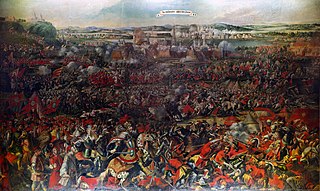
The Battle of Vienna took place at Kahlenberg Mountain near Vienna on 12 September 1683 after the city had been besieged by the Ottoman Empire for two months. The battle was fought by the Holy Roman Empire and the Polish–Lithuanian Commonwealth, both under the command of King John III Sobieski, against the Ottomans and their vassal and tributary states. The battle marked the first time the Commonwealth and the Holy Roman Empire had cooperated militarily against the Ottomans. The defeat is often seen as a turning point for Ottoman expansion into Europe, after which they would gain no further ground. In the ensuing war that lasted until 1699, the Ottomans would cede most of Ottoman Hungary to Leopold I, Holy Roman Emperor.
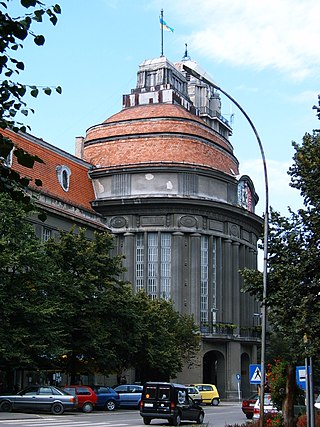
Senta is a town and municipality located in the North Banat District of the autonomous province of Vojvodina, Serbia. It is situated on the bank of the Tisa river in the geographical region of Bačka. The town has a population of 18,704, whilst the Senta municipality has 23,316 inhabitants.
Köprülüzade Fazıl Mustafa Pasha ("Köprülü Mustafa Pasha the Wise", also known as Gazi Fazıl Mustafa Köprülü served as the Grand Vizier of the Ottoman Empire from 1689 to 1691, when the Empire was engaged in a war against the Holy League countries in the Great Turkish War. He was the son of Ayşe Hatun, of Turkish origin, and of Köprülü Mehmed Pasha. He was thus a member of the Köprülü family of Albanian origin through his father. His father, his elder brother Köprülü Fazıl Ahmed Pasha, as well as his two brothers-in-law were former grand viziers. His epithet Fazıl means "wise" in Ottoman Turkish.

The Battle of Slankamen was fought on 19 August 1691, near Slankamen in the Ottoman Sanjak of Syrmia, between the Ottoman Empire, and Habsburg Austrian forces during the Great Turkish War.

A series of military conflicts between the Ottoman Empire and various European states took place from the Late Middle Ages up through the early 20th century. The earliest conflicts began during the Byzantine–Ottoman wars, waged in Anatolia in the late 13th century before entering Europe in the mid-14th century with the Bulgarian–Ottoman wars. The mid-15th century saw the Serbian–Ottoman wars and the Albanian-Ottoman wars. Much of this period was characterized by the Ottoman expansion into the Balkans. The Ottoman Empire made further inroads into Central Europe in the 15th and 16th centuries, culminating in the peak of Ottoman territorial claims in Europe.

The Great Turkish War, also called the Wars of the Holy League, was a series of conflicts between the Ottoman Empire and the Holy League consisting of the Holy Roman Empire, Poland-Lithuania, Venice, Russia, and the Kingdom of Hungary. Intensive fighting began in 1683 and ended with the signing of the Treaty of Karlowitz in 1699. The war was a defeat for the Ottoman Empire, which for the first time lost substantial territory, in Hungary and the Polish–Lithuanian Commonwealth, as well as in part of the western Balkans. The war was significant also for being the first instance of Russia joining an alliance with Western Europe.

The Austro-Turkish War (1716–1718) was fought between Habsburg monarchy and the Ottoman Empire. The 1699 Treaty of Karlowitz was not an acceptable permanent agreement for the Ottoman Empire. Twelve years after Karlowitz, it began the long-term prospect of taking revenge for its defeat at the Battle of Vienna in 1683. First, the army of Turkish Grand Vizier Baltacı Mehmet defeated Peter the Great's Russian Army in the Russo-Turkish War (1710–1711). Then, during the Ottoman–Venetian War (1714–1718), Ottoman Grand Vizier Damat Ali reconquered the Morea from the Venetians. As the guarantor of the Treaty of Karlowitz, the Austrians threatened the Ottoman Empire, which caused it to declare war in April 1716.

The Second Battle of Mohács, also known as the Battle of Harsány Mountain, was fought on 12 August 1687 between the forces of Ottoman Sultan Mehmed IV, commanded by the Grand Vizier Sarı Süleyman Pasha, and the forces of Leopold I, Holy Roman Emperor, commanded by Charles of Lorraine. The result was a decisive victory for the Austrians.

The Battle of Petrovaradin also known as the Battle of Peterwardein, took place on 5 August 1716 during the Austro-Turkish War when the Ottoman army besieged the Habsburg-controlled fortress of Petrovaradin on the Military Frontier of the Habsburg monarchy. The Ottomans attempted to capture Petrovaradin, the so-called Gibraltar on the Danube, but experienced a great defeat by an army half the size of their own, similar to the defeat they had experienced in 1697 at Zenta. Ottoman Grand Vizier Damad Ali Pasha was fatally wounded, while the Ottoman army lost 20,000 men and 250 guns to the Habsburg army led by Field Marshal Prince Eugene of Savoy.

Amcazade Köprülü Hüseyin Pasha (1644–1702) of the Köprülü family, was the grand vizier of the Ottoman Empire under Mustafa II from September 1697 until September 1702. Amcazade Koprulu Huseyin Pasha was close to ordinary Ottoman Muslim subjects being a member of the Mevlevi Order. He was known to be concerned with the needs of the common people as well as those of the military and bureaucratic classes.

The Battle of Keresztes took place on 24–26 October 1596. It was fought between a combined Habsburg-Transylvanian force and the Ottoman Empire near the village of Mezőkeresztes in modern-day northern Hungary. The Ottomans routed the Habsburg-led army but due to their own losses were unable to exploit their victory.
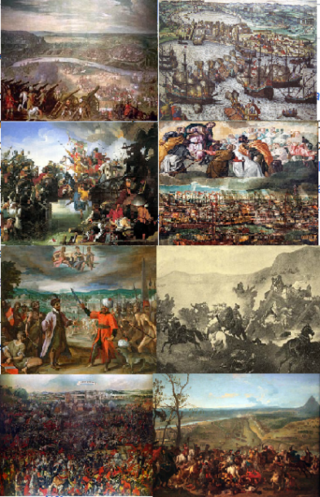
The Ottoman–Habsburg wars were fought from the 16th to the 18th centuries between the Ottoman Empire and the Habsburg monarchy, which was at times supported by the Kingdom of Hungary, Polish–Lithuanian Commonwealth, and Habsburg Spain. The wars were dominated by land campaigns in Hungary, including Transylvania and Vojvodina, Croatia, and central Serbia.
The territorial evolution of the Ottoman Empire spans seven centuries.
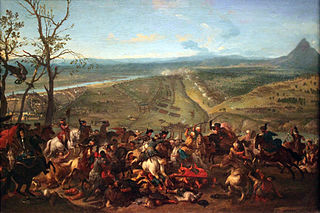
The siege of Belgrade was a successful attempt by Austrian troops under the command of Prince Eugene of Savoy to capture the strategically important city of Belgrade from the Ottoman Empire. It took place during the Austro-Turkish War (1716–1718), barely a year after the Austrian victory at the Battle of Petrovaradin (Peterwardein). The Imperial Army routed the Ottoman relief army under Grand Vizier Hacı Halil Pasha on 16 August. As a consequence, the Belgrade garrison, deprived of relief, surrendered to the Austrians on 21 August. The Ottoman Sultan Ahmed III sued for peace, resulting in the Treaty of Passarowitz a year later, which completed the transfer of the remainder of Hungary, the Banat and the city of Belgrade into Austrian hands.
Elmas Mehmed Pasha was an Ottoman statesman who served as grand vizier from 1695 to 1697. His epithet Elmas means "diamond" in Persian and refers to his fame as a handsome man.
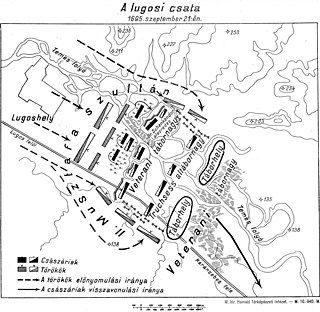
The Battle of Lugos was fought on 21 September 1695 near the city of Lugos in the East Banat, between the forces of the Ottoman Empire and the forces of the Habsburg monarchy as part of the Great Turkish War.

The Battle of Olasch took place after a Habsburg Imperial army led by Saxon Elector General, Augustus II the Strong, laid siege to Turkish held Temesvár. On 26 August 1696, after learning that Sultan Mustafa II's relief army was crossing the Danube at Pancsova, Augustus gave up the siege and headed to meet the Ottoman army. The battle near the Bega River resulted in a draw after both armies retreated with heavy casualties on both sides. Strategically, the Ottoman army's campaign can be considered a success, as it achieved its goal of retaining Temesvár.

Jovan Popović Tekelija was a Serb army officer serving in the Habsburg army. As commander of the Serbian Militia, Tekelija participated in many battles distinguishing himself in particular during the Battle of Zenta in 1697 where the Ottoman Empire suffered a stunning defeat. For his merit, he was appointed Captain of the Serbian militia in Arad and ennobled by Emperor Joseph I.
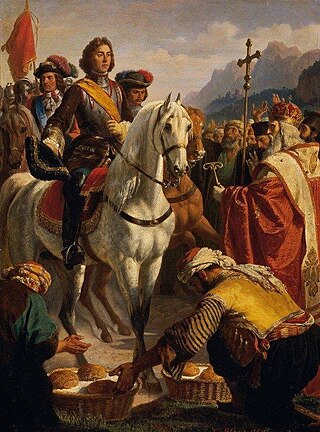
The sack of Sarajevo took place on 23 October 1697 and was committed by raiding Austrian troops led by Prince Eugene of Savoy. At this time the Great Turkish War was being fought. Shortly after the Austrian victory at the Battle of Zenta, an opportunity arose for the Austrians to launch a surprise attack into Ottoman Bosnia.























